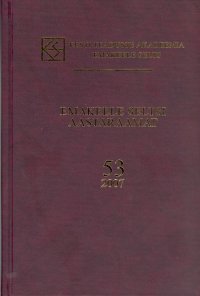Haabju ja eistuk
Haabju and eistuk
Author(s): Helmi Neetar, Vilja OjaSubject(s): Language and Literature Studies
Published by: Teaduste Akadeemia Kirjastus
Keywords: eistuk; haabju; loanword; Finnic; boat; Swedish
Summary/Abstract: The boat names haabju and eistuk have been used in parallel on the northern Estonian coast from Naissaar to Mahu, while eistuk occurs sporadically also in Keila, Risti, Saaremaa and Hiiumaa (see Maps 2 and 3). Both have been recorded in numerous dialectal variants: haabju – aabju, aabiju, (h)aabja, (h)aabi, (h)aab, aabin, and eistuk – (h)eistuk, (h)eistük, eistrik, eistruk, eistrük, eestok, hööstuk. The standard Estonian boat name haabjas has not been recorded from dialect usage. The areal spread and phonetic shape of the words suggest their being borrowed from the northern coast of the Gulf of Finland, haabju probably originating from Finnish dialects, and eistuk from the Swedish-speaking area of Finland. Evidently the uup of Vigala subdialect also originates in the Finnish haapio, but it has travelled to Estonian via Swedish dialects (< erts håp). With our neighbours both haabju and eistuk have originally referred to boats hollowed out of a single trunk, indicating, at the same time, the name of the tree used – oak for the Swedish ekstock ~ ökstock, and aspen (haapa) for Finnish haapio. If a Swede wanted to differentiate between such Finnic aspen boat from the West-European one made of oak, he would use a Swedish form håp of its Finnish equivalent. In Estonian dialects eistuk and haabju stood for plank boats of different shapes and sizes, without any association with the trees just mentioned. The smaller one, the eistuk, was a fl at-bottomed small boat truncated at both ends, without keel or stem, about 1.5–3.6 m long, whereas haabju had sharp ends, in most cases also a sharp bottom and keel, its length was 3–4.5 m. Both were used in fi shing and seal-hunting as well as for other offshore trips, and also as ship boats. The uup of Vigala was rather similar to an eistuk, which was a trough-like plank boat, but in addition, uup, like the Estonian-Swedish håp, has been used to refer to an aspen hollowed-out boat. As the Estonian eistuk and haabju designate small plank boats and not hollowed-out boats, the borrowing must have taken place after an analogous change of reference had taken place with the neighbouring peoples.
Journal: Emakeele Seltsi aastaraamat
- Issue Year: 2007
- Issue No: 53
- Page Range: 087-103
- Page Count: 17
- Language: Estonian

